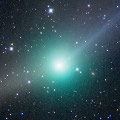
|
Now it is 6.6 mag (Feb. 20, Juan Jose Gonzalez). It keeps bright as 7 mag and observable in excellent condition until April. Then it will be fading and will be unobservable in June. In the Southern Hemisphere, it is not observable now. It will be observable in the evening low sky from April to June.
Date(TT) R.A. (2000) Decl. Delta r Elong. m1 Best Time(A, h)
Feb. 25 16 5.03 61 38.1 1.294 1.775 101 6.4 5:11 (190, 63)
Mar. 3 15 1.90 67 28.8 1.268 1.822 106 6.5 4:20 (180, 58)
|
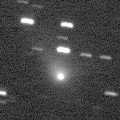
|
Now it is very bright as 9.5 mag (Feb. 11, Katsumi Yoshimoto). It will keep 10 mag until March, but it will be too low to observe. It is already unobservable in the Southern Hemisphere.
Date(TT) R.A. (2000) Decl. Delta r Elong. m1 Best Time(A, h)
Feb. 25 0 3.74 -2 24.8 1.866 1.048 24 10.4 19:15 ( 83, 5)
Mar. 3 0 33.87 -1 47.9 1.884 1.070 24 10.6 19:21 ( 84, 5)
|
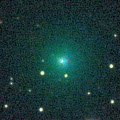
|
New comet discovered on Feb. 11. It is very bright as 10.6 mag (Feb. 12, A. Novichonok, V. Gerke). It has approached to the earth down to 0.2 A.U. in late January. Then it must have been bright as 10 mag and located in excellent position. It will approach to the sun down to 0.8 A.U. in mid March. It is already unobservable in the Southern Hemisphere. In the Northern Hemisphere, it keeps observable until mid March, although it will be getting lower in the evening sky. However, the comet is getting diffuse and fading rapidly after Feb. 20 (Artyom Novichonok and Vladimir Gerke). After the perihelion passage, it will appear in the morning sky in May. But it may be impossible to observe at that time.
Date(TT) R.A. (2000) Decl. Delta r Elong. m1 Best Time(A, h)
Feb. 25 1 22.08 16 36.3 1.049 0.863 49 11.6 19:15 ( 89, 31)
Mar. 3 1 12.04 16 0.1 1.262 0.823 40 11.7 19:21 ( 95, 22)
|
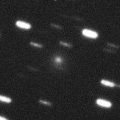
|
It was observed as bright as 13.9 mag in 2011 autumn (Oct. 19, Hidetaka Sato). It is not observable now. In the Northern Hemisphere, it will be observable again in 2012 summer, when it will be fainter than 15 mag. In the Southern Hemisphere, it will never be observable again.
Date(TT) R.A. (2000) Decl. Delta r Elong. m1 Best Time(A, h)
Feb. 25 22 23.80 11 18.7 2.333 1.451 20 12.2 5:11 (253, -5)
Mar. 3 22 45.15 14 42.4 2.367 1.491 21 12.3 5:03 (250, -3)
|

|
Now it is very bright as 11.0 mag (Feb. 10, Uwe Pilz). In the Northern Hemisphere, it keeps observable at 11-12 mag in good condition until March, but it will be unobservable in April. It is already low in the Southern Hemisphere.
Date(TT) R.A. (2000) Decl. Delta r Elong. m1 Best Time(A, h)
Feb. 25 2 18.70 10 54.9 2.337 2.040 60 12.7 19:15 ( 74, 40)
Mar. 3 2 33.57 11 59.1 2.409 2.050 57 12.8 19:21 ( 78, 37)
|

|
It brightened up to 17.1 mag in late June in 2011 (June 24, J. F. Hernandez). The condition of this apparition is bad, and it is not observable around the perihelion passage. It will appear in the morning sky at 14 mag in pril in the Southern Hemisphere. It will not be observable until June in the Northern Hemisphere, when the comet will be 15.5 mag.
Date(TT) R.A. (2000) Decl. Delta r Elong. m1 Best Time(A, h)
Feb. 25 21 33.48 -20 36.3 2.626 1.708 17 13.5 5:11 (286,-13)
Mar. 3 21 52.74 -19 13.3 2.635 1.735 19 13.6 5:03 (285,-12)
|
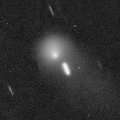
|
Now it is bright as 13.5 mag and visible visually (Jan. 20, Chris Wyatt). It keeps bright as 13-14 mag for a long time after this until 2013. It is not observable in the Northern Hemisphere, but it is observable in good condition in the Southern Hemisphere.
Date(TT) R.A. (2000) Decl. Delta r Elong. m1 Best Time(A, h)
Feb. 25 2 9.38 -71 47.6 5.719 5.470 70 13.5 19:15 ( 15,-22)
Mar. 3 2 19.62 -70 3.5 5.715 5.474 71 13.5 19:21 ( 18,-23)
|
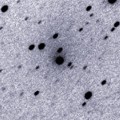
|
Small outburst occured on Feb. 17 (Richard Miles). Now it is visible visually at 14.0 mag (Feb. 19, Alan Hale).
Date(TT) R.A. (2000) Decl. Delta r Elong. m1 Best Time(A, h)
Feb. 25 12 35.28 -13 27.7 5.457 6.260 141 13.7 2:20 ( 0, 41)
Mar. 3 12 32.91 -13 22.7 5.393 6.260 148 13.6 1:50 ( 0, 42)
|

|
Big asteroid discovered in 1906. It suddenly showed the cometary activity on Dec. 11, 2010, probably due to an impact of a small object. It was very bright as 11.5 mag visually (Dec. 17, 2010, Juan Jose Gonzalez). Now it is 14.1 mag (Jan. 3, Hidetaka Sato). It has already turned to be stellar.
Date(TT) R.A. (2000) Decl. Delta r Elong. m1 Best Time(A, h)
Feb. 25 16 28.97 -14 31.6 2.305 2.473 87 13.8 5:11 (341, 38)
Mar. 3 16 36.64 -15 0.2 2.212 2.469 92 13.7 5:03 (344, 39)
|
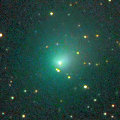
|
It reached up to 9.7 mag with a large bright coma in autumn (Oct. 29, Juan Jose Gonzalez). It will be fading after this. Outburst occured on Jan. 2, but it has been already diffuse and fading. It has already faded down to 12.8 mag (Feb. 20, Sandor Szabo). It will be unobservable in late March in the Northern Hemisphere, or late April in the Southern Hemisphere.
Date(TT) R.A. (2000) Decl. Delta r Elong. m1 Best Time(A, h)
Feb. 25 2 59.09 -6 6.8 3.092 2.849 66 13.8 19:15 ( 49, 35)
Mar. 3 3 2.81 -6 33.3 3.249 2.905 61 14.0 19:21 ( 56, 30)
|
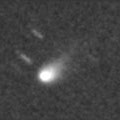
|
It is expected to be bright as 9 mag from 2012 to 2013. Now it is 14.1 mag and visible visually (Feb. 22, Sandor Szabo). In the Northern Hemisphere, it keeps observable in good condition for a long time until 2012 autumn when the comet brightens up to 10 mag. In the Southern Hemisphere, it is hardly observble before the perihelion passage. But it becomes observable in good condition since 2013 after the perihelion passage.
Date(TT) R.A. (2000) Decl. Delta r Elong. m1 Best Time(A, h)
Feb. 25 15 40.90 49 58.9 3.710 4.080 105 14.0 5:11 (188, 75)
Mar. 3 15 42.86 51 1.1 3.618 4.017 106 13.8 4:59 (180, 74)
|
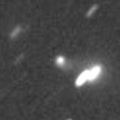
|
It brightened up to 14.1 mag in August and September (Aug. 11, Artyom Novichonok and Vladimir Gerke). Although it has been unobservable for a while, now it is appearing in the morning sky. After this, it will be observable in good condition in the Southern Hemisphere while fading gradually. It will locate somewhat low in the Northern Hemisphere. In 2011, some visual observers reported it was very bright as 10-12 mag.
Date(TT) R.A. (2000) Decl. Delta r Elong. m1 Best Time(A, h)
Feb. 25 20 27.13 -14 58.1 3.277 2.475 30 14.0 5:11 (291, 3)
Mar. 3 20 41.23 -14 51.3 3.260 2.501 34 14.0 5:03 (292, 4)
|
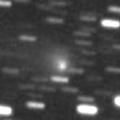
|
It was already visible visually at 14.3 mag in 2011 (Oct. 1, Jakub Cerny). Although it has been unobservable for a while, it is appearing in the morning sky now. It keeps 13-14 mag and observable in good condition until September.
Date(TT) R.A. (2000) Decl. Delta r Elong. m1 Best Time(A, h)
Feb. 25 18 14.15 -14 5.4 5.527 5.146 62 14.0 5:11 (314, 27)
Mar. 3 18 13.23 -14 1.2 5.402 5.142 69 14.0 5:03 (318, 30)
|
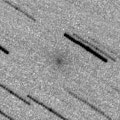
|
A comet discovered from the SOHO spacecraft images in 2003 was rediscovered from the STEREO spacecraft images. It is still bright as 15.3 mag (Feb. 19, Mitsunori Tsumura). It may be visible visually. It will be fading gradually, but getting higher after this. It locates very low in the Southern Hemisphere.
Date(TT) R.A. (2000) Decl. Delta r Elong. m1 Best Time(A, h)
Feb. 25 1 55.57 0 9.3 0.804 0.805 52 14.1 19:15 ( 67, 29)
Mar. 3 2 48.46 4 7.5 0.789 0.895 59 14.8 19:21 ( 67, 36)
|

|
It was expected to keep 14-15 mag for a long time from 2011 summer to 2012 summer. However, it is lost. It was observed only during two days in 2010 June. So the orbital elements are extremely uncertain. The condition is good in the Southern Hemisphere. But in the Northern Hemisphere, it is not observable until August.
Date(TT) R.A. (2000) Decl. Delta r Elong. m1 Best Time(A, h)
Feb. 25 1 26.43 -56 25.1 2.671 2.307 58 14.3 19:15 ( 30,-15)
Mar. 3 1 50.43 -52 52.1 2.681 2.315 58 14.3 19:21 ( 34,-14)
|
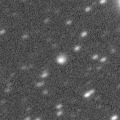
|
Now it is visible visually at 14.3 mag (Jan. 20, Sandor Szabo). It is expected to be 13 mag and will be observable in good condition in 2013. In the Northern Hemisphere, it keeps observable for a long time after this. It is not observable in the Southern Hemisphere. It will turn to be in the morning sky after mid March.
Date(TT) R.A. (2000) Decl. Delta r Elong. m1 Best Time(A, h)
Feb. 25 23 8.03 48 38.2 7.151 6.691 58 14.7 19:15 (135, 22)
Mar. 3 23 10.69 48 30.4 7.181 6.668 55 14.6 19:21 (138, 17)
|

|
Now it is 15.0 mag (Jan. 17, Yasukazu Ikari). It is already unobservable in the Northern Hemisphere. It will be unobservable in mid March also in the Southern Hemisphere. It is expected to be observable at 13 mag for a long time from 2012 summer to 2013 summer. It will be observable in excellent condition in the Southern Hemisphere. But it is not observable at brightest time in the Northern Hemisphere.
Date(TT) R.A. (2000) Decl. Delta r Elong. m1 Best Time(A, h)
Feb. 25 1 10.93 -32 17.8 4.044 3.397 43 14.8 19:15 ( 50, -1)
Mar. 3 1 14.47 -32 6.4 4.025 3.340 40 14.8 19:21 ( 55, -6)
|
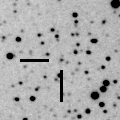
|
Now it is 15.0 mag (Feb. 13, V. Gerke, S. Plaksa, A. Novichonok, D. Chestnov). In the Northern Hemisphere, it keeps observable at 14-15 mag in good condition until early 2013. In the Southern Hemisphere, it is not observable until late 2012.
Date(TT) R.A. (2000) Decl. Delta r Elong. m1 Best Time(A, h)
Feb. 25 19 52.90 32 51.3 3.154 2.734 56 15.6 5:11 (252, 36)
Mar. 3 20 1.08 35 43.5 3.056 2.686 59 15.4 5:03 (250, 39)
|
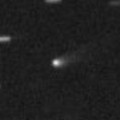
|
Now it is bright as 14.6 mag (Feb. 3, Yasukazu Ikari). Although it was extremely faint as 20.5 mag at the recovery in 2010 autumn, it brightened rapidly. It will keep 15 mag and observable in good condition for a long time from 2012 to 2013. But it locates somewhat low in the Northern Hemisphere in 2013.
Date(TT) R.A. (2000) Decl. Delta r Elong. m1 Best Time(A, h)
Feb. 25 13 37.29 11 18.7 2.601 3.363 133 15.5 3:21 ( 0, 66)
Mar. 3 13 35.93 11 52.6 2.524 3.347 140 15.4 2:52 ( 0, 67)
|
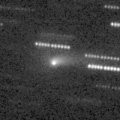
|
It reached up to 11-12 mag in 2011 autumn. Now it is fading. It has already faded down to 15.8 mag (Feb. 17, J. Vales). But it has a very long tail. It keeps observable in good condition until May when it becomes fainter than 18 mag. It locates somewhat low in the Southern Hemisphere.
Date(TT) R.A. (2000) Decl. Delta r Elong. m1 Best Time(A, h)
Feb. 25 12 25.75 26 23.9 1.060 1.969 147 16.0 2:10 ( 0, 81)
Mar. 3 12 20.43 28 6.2 1.091 2.016 150 16.0 1:37 ( 0, 83)
|
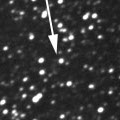
|
It is expected to be a great comet of 0 mag in 2013 spring. Now it is 14.5 mag (Feb. 13, R. Naves, M. Campas), brightening well. In 2012, it keeps observable until summer while brightening gradually. It locates somewhat low in the Northern Hemisphere.
Date(TT) R.A. (2000) Decl. Delta r Elong. m1 Best Time(A, h)
Feb. 25 16 58.76 -23 28.2 5.570 5.479 79 16.1 5:11 (336, 28)
Mar. 3 17 0.07 -23 42.0 5.380 5.408 86 16.0 5:03 (341, 29)
|
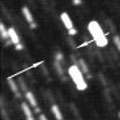
|
In the Southern Hemisphere, it is appearing int he morning sky. It will be observable at 15-16 mag in good condition for a long time until 2013 summer. It is not observable at all in the Northern Hemisphere.
Date(TT) R.A. (2000) Decl. Delta r Elong. m1 Best Time(A, h)
Feb. 25 19 22.75 -41 7.2 4.714 4.176 51 16.1 5:11 (320, -3)
Mar. 3 19 30.72 -42 13.0 4.605 4.155 57 16.0 5:03 (322, -3)
|
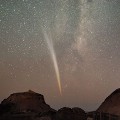
|
New Kreutz sungrazer comet discovered on the ground after 41-year blank since Comet C/1970 K1 (White-Ortiz-Bolelli). It approached nearly to the surface of the Sun on Dec. 16, and reached -4 mag or brighter at best. Then it appeared in the morning sky in the Southern Hemisphere, and it became a great comet with a bright long tail of 30-40 degrees. Now it is 12.0 mag (Jan. 27, Alan Hale). However, the nucleus of the comet is not visible at all, fainter than 19 mag (Jan. 2, Robert McNaught). Probably the comet itself has already disappeared and only the remnant is visible. The tail became extremely faint, but the long tail of 2 degrees is detectable by photos still now with an excellent sky condition (Feb. 21, Lester Barnes). Now it is observable also in the Northern Hemisphere.
Date(TT) R.A. (2000) Decl. Delta r Elong. m1 Best Time(A, h)
Feb. 25 4 59.90 -17 55.4 1.523 1.876 94 16.0 19:15 ( 10, 37)
Mar. 3 5 5.52 -15 0.3 1.725 1.997 90 16.7 19:21 ( 19, 38)
|
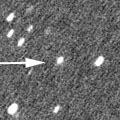
|
Now it is 16.5 mag (Feb. 4, V. Gerke, S. Plaksa, A. Novichonok, D. Chestnov). In the Northern Hemisphere, it keeps observable at 16-17 mag in good condition for a long time from 2012 to 2013. It is not observable in the Southern Hemisphere.
Date(TT) R.A. (2000) Decl. Delta r Elong. m1 Best Time(A, h)
Feb. 25 12 14.15 57 30.7 3.529 4.210 127 17.0 1:59 (180, 68)
Mar. 3 11 59.37 59 50.1 3.521 4.177 125 16.9 1:17 (180, 65)
|
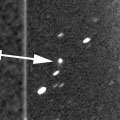
|
It is expected to keep 13 mag and observable in good condition in the Northern Hemisphere for a long time from 2013 to 2014. Now it is 16.7 mag (Feb. 4, P. Dupouy). It keeps observable at 17-18 mag in good condition until June.
Date(TT) R.A. (2000) Decl. Delta r Elong. m1 Best Time(A, h)
Feb. 25 11 8.59 2 20.1 5.715 6.686 167 17.0 0:53 ( 0, 57)
Mar. 3 11 3.79 3 15.7 5.651 6.640 175 17.0 0:21 ( 0, 58)
|
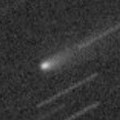
|
It is bright as 16.1 mag still now (Jan. 23, Hidetaka Sato). After a small outburst in early December, it keeps its brightness without fading. It will keep 16 mag some more time. It is observable in good condition in the Southern Hemipshere. It keeps locating very low in the Northern Hemisphere.
Date(TT) R.A. (2000) Decl. Delta r Elong. m1 Best Time(A, h)
Feb. 25 15 20.15 -40 13.7 1.724 2.087 96 17.0 5:04 ( 0, 15)
Mar. 3 15 21.89 -41 4.6 1.717 2.164 102 17.2 4:38 ( 0, 14)
|

|
It brightened up to 13-14 mag and became visible visually from 2007 to 2009. Now it is fading. But it is still bright as 16.1 mag (Feb. 13, Gerke, S. Plaksa, A. Novichonok, D. Chestnov). In the Northern Hemisphere, it keeps observable in excellent condition until early summer in 2012. In the Southern Hemisphere, it locates extremely low only.
Date(TT) R.A. (2000) Decl. Delta r Elong. m1 Best Time(A, h)
Feb. 25 10 20.22 40 20.4 10.590 11.450 149 17.2 0:05 (180, 85)
Mar. 3 10 16.05 40 28.2 10.658 11.486 145 17.2 23:29 (180, 85)
|
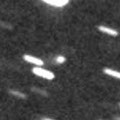
|
Now it is 17.1 mag (Feb. 11, P. Dupouy). It keeps observable at 17 mag for a long time from 2011 to 2013. In 2012, it keeps observable in good condition until early September.
Date(TT) R.A. (2000) Decl. Delta r Elong. m1 Best Time(A, h)
Feb. 25 16 37.11 0 33.4 5.597 5.654 88 17.3 5:11 (331, 52)
Mar. 3 16 34.44 1 7.1 5.467 5.649 95 17.2 5:03 (339, 54)
|
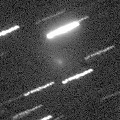
|
First return of a new comet which brightened up to 9.5 mag in a major outburst in 2006. It was recovered on Dec. 17, but much fainter than expected. However, it looks very diffuse, and the total magnitude was bright as 13.5 mag (Dec. 26, Michael Jager). It approached to the earth down to 0.24 A.U. in late January, then it was still bright as 15.9 mag (Jan. 25, Yasukazu Ikari). It will keep close to the earth and observable in good condition in the evening sky for a while after this. However, it may fade out very rapidly after this.
Date(TT) R.A. (2000) Decl. Delta r Elong. m1 Best Time(A, h)
Feb. 25 6 13.49 -24 30.0 0.355 1.155 108 17.3 19:57 ( 0, 30)
Mar. 3 6 47.91 -25 11.3 0.406 1.203 111 18.2 20:03 ( 0, 30)
|
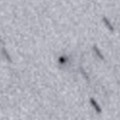
|
Now it is 16.0 mag (Feb. 13, V. Gerke, S. Plaksa, A. Novichonok, D. Chestnov). It became brightest after the perihelion passage as predicted. It is observable in excellent condition in the Northern Hemisphere. It locates somewhat low in the Southern Hemisphere. It will be fading after this. But it may be brighter than this ephemeris.
Date(TT) R.A. (2000) Decl. Delta r Elong. m1 Best Time(A, h)
Feb. 25 10 53.40 31 25.6 1.915 2.853 157 17.4 0:38 ( 0, 86)
Mar. 3 10 46.70 32 0.3 1.966 2.893 154 17.6 0:04 ( 0, 87)
|
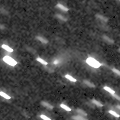
|
Now it is 17.2 mag (Feb. 13, V. Gerke, S. Plaksa, A. Novichonok, D. Chestnov). It keeps observable in good condition for a while after this. But it will be fainter than 18 mag in late March.
Date(TT) R.A. (2000) Decl. Delta r Elong. m1 Best Time(A, h)
Feb. 25 7 19.69 2 3.9 1.653 2.431 132 17.4 21:01 ( 0, 57)
Mar. 3 7 20.78 2 37.6 1.727 2.447 126 17.6 20:34 ( 0, 58)
|
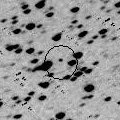
|
Peculiar asteroid moving along a cometary orbit. Now it is 17.4 mag (Jan. 4, Catalina Sky Survey). It keeps observable at 18 mag for a long time from 2008 to 2014.
Date(TT) R.A. (2000) Decl. Delta r Elong. m1 Best Time(A, h)
Feb. 25 7 12.16 17 53.5 5.988 6.684 131 17.5 20:53 ( 0, 73)
Mar. 3 7 8.94 18 33.6 6.091 6.691 123 17.6 20:22 ( 0, 74)
|
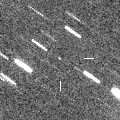
|
Now it is 20.5 mag (Feb. 11, Mt. Lemmon Survey), much fainter than this ephemeris. But it is expected to bright rapidly after this, and reach up to 16.5 mag from spring to summer. However, it locates extremely low in the Southern Hemisphere. In the Northern Hemisphere, it locates high now. But it will be getting lower gradually in the evening sky, and will be unobservable in June.
Date(TT) R.A. (2000) Decl. Delta r Elong. m1 Best Time(A, h)
Feb. 25 3 4.21 17 47.9 1.809 1.790 73 17.7 19:15 ( 72, 53)
Mar. 3 3 18.93 18 32.1 1.845 1.763 69 17.5 19:21 ( 77, 50)
|
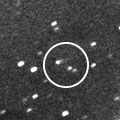
|
Now it is 17.5 mag (Jan. 31, K. Hills). It will brighten up to 13 mag in 2014. In 2012, it is observable at 17.5 mag in good condition in spring.
Date(TT) R.A. (2000) Decl. Delta r Elong. m1 Best Time(A, h)
Feb. 25 11 24.70 15 36.9 3.393 4.357 165 17.6 1:09 ( 0, 71)
Mar. 3 11 20.45 16 4.7 3.366 4.344 168 17.6 0:37 ( 0, 71)
|
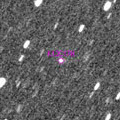
|
Now it is 17.8 mag (Feb. 11, C. Rinner, F. Kugel). It will brighten up to 13.5 mag from summer to autumn. It keeps observable for a long time until December. In the Northern Hemisphere, it locates high until spring. But after that, it keeps locating low in the evening. In the Southern Henmisphere, it keeps locating low all through the time.
Date(TT) R.A. (2000) Decl. Delta r Elong. m1 Best Time(A, h)
Feb. 25 11 34.89 28 33.3 2.237 3.164 155 17.8 1:19 ( 0, 83)
Mar. 3 11 29.91 30 5.6 2.161 3.090 155 17.6 0:47 ( 0, 85)
|
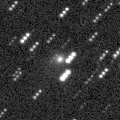
|
Although it has passed the perihelion in 2010 November, it is uxexpectedly bright as 16.9 mag still now (Feb. 11, P. Dupouy). It keeps observable in excellent condition for a while. It will keep 16-17 mag for a while after this.
Date(TT) R.A. (2000) Decl. Delta r Elong. m1 Best Time(A, h)
Feb. 25 5 28.18 14 7.6 4.935 5.300 106 17.6 19:15 ( 3, 69)
Mar. 3 5 26.37 14 54.0 5.104 5.350 99 17.7 19:21 ( 27, 68)
|
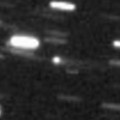
|
Now it is 17.5 mag (Feb. 10, P. Dupouy). It keeps observable at 18 mag for a long time until 2013.
Date(TT) R.A. (2000) Decl. Delta r Elong. m1 Best Time(A, h)
Feb. 25 5 4.21 25 16.4 3.597 3.921 101 17.7 19:15 ( 34, 78)
Mar. 3 5 7.35 25 15.9 3.701 3.922 95 17.7 19:21 ( 57, 74)
|

|
It has not been observed since 2011 February. But it must be already bright as 18 mag. It will brighten up to 17 mag and will be observable in good condition from spring to summer.
Date(TT) R.A. (2000) Decl. Delta r Elong. m1 Best Time(A, h)
Feb. 25 17 41.06 -17 5.7 2.161 2.051 70 17.8 5:11 (323, 29)
Mar. 3 17 55.47 -16 39.8 2.093 2.051 73 17.7 5:03 (324, 30)
|
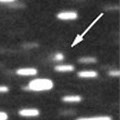
|
It reached up to 15.3 mag in early summer in 2011 (June 19, Toshiyuki Takahashi). Now it is fading. It has already faded down to 17.4 mag (Jan. 26, P. Dupouy). It will be fainter than 18 mag in March. I will locate high in the Southern Hemishere, but somewhat low in the Northern Hemisphere after this.
Date(TT) R.A. (2000) Decl. Delta r Elong. m1 Best Time(A, h)
Feb. 25 16 13.72 -20 28.2 2.566 2.757 90 17.8 5:11 (347, 33)
Mar. 3 16 18.42 -21 6.6 2.499 2.786 96 17.8 5:03 (351, 33)
|
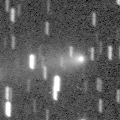
|
It had been fading after the perihelion passage in 2010 October, but it brightened again in outburst on Apr. 5, 2011. It reached up to 14.7 mag in May (May 28, Hidetaka Sato). It has been unobservable since July. But it is appearing in the morning sky now. Now it is 17.1 mag, much brighter than expected (Dec. 17, Ken-ichi Kadota). It locates low in the Southern Hemisphere. But in the Northern Hemisphere, it keeps observable in good condition after this. It will keep 17 mag for a while.
Date(TT) R.A. (2000) Decl. Delta r Elong. m1 Best Time(A, h)
Feb. 25 13 46.92 18 24.1 3.192 3.918 131 18.0 3:31 ( 0, 73)
Mar. 3 13 44.24 19 4.8 3.158 3.945 137 18.1 3:01 ( 0, 74)
|
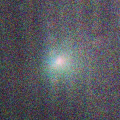
|
It was observed so bright as 9.4 mag in September (Sept. 22, Chris Wyatt). It has got diffuse and faded rapidly. It has already faded down to 18 mag (Feb. 14, V. Gerke, S. Plaksa, A. Novichonok, D. Chestnov). It is observable in good condition in the Northern Hemisphere. It is not observable in the Southern Hemisphere. Sandor Szabo reported it was visible visually at 15.4 mag on Feb. 22.
Date(TT) R.A. (2000) Decl. Delta r Elong. m1 Best Time(A, h)
Feb. 25 11 46.96 56 22.6 1.761 2.521 130 18.3 1:33 (180, 69)
Mar. 3 11 5.20 58 6.9 1.862 2.599 128 18.6 0:24 (180, 67)
|
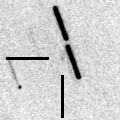
|
It had expected to keep 17 mag for a long time from 2011 summer to 2012 spring and observable in good condition in the Southern Hemisphere. But actually, it has faded down to 20.3 mag (Jan. 28, D. Herald), much fainter than expected by 4 mag.
Date(TT) R.A. (2000) Decl. Delta r Elong. m1 Best Time(A, h)
Feb. 25 7 25.88 -51 57.7 1.911 2.396 107 20.5 21:06 ( 0, 3)
Mar. 3 7 18.53 -46 14.0 1.944 2.445 108 20.6 20:31 ( 0, 9)
|
|
![]()
 C/2010 S1 ( LINEAR )
C/2010 S1 ( LINEAR ) C/2011 R1 ( McNaught )
C/2011 R1 ( McNaught ) C/2011 UF305 ( LINEAR )
C/2011 UF305 ( LINEAR ) 246P/2010 V2 ( NEAT )
246P/2010 V2 ( NEAT ) 49P/Arend-Rigaux
49P/Arend-Rigaux C/2011 L4 ( PanSTARRS )
C/2011 L4 ( PanSTARRS ) C/2011 O1 ( LINEAR )
C/2011 O1 ( LINEAR ) C/2011 W3 ( Lovejoy )
C/2011 W3 ( Lovejoy ) C/2012 A2 ( LINEAR )
C/2012 A2 ( LINEAR ) C/2011 J2 ( LINEAR )
C/2011 J2 ( LINEAR ) C/2011 S2 ( Kowalski )
C/2011 S2 ( Kowalski ) C/2005 L3 ( McNaught )
C/2005 L3 ( McNaught ) C/2010 R1 ( LINEAR )
C/2010 R1 ( LINEAR ) 255P/2011 Y1 ( Levy )
255P/2011 Y1 ( Levy ) 164P/Christensen
164P/Christensen P/2011 W2 ( Rinner )
P/2011 W2 ( Rinner ) 2008 YB3
2008 YB3 60P/Tsuchinshan 2
60P/Tsuchinshan 2 117P/Helin-Roman-Alu 1
117P/Helin-Roman-Alu 1 C/2012 CH17 ( MOSS )
C/2012 CH17 ( MOSS ) C/2010 FB87 ( WISE-Garradd )
C/2010 FB87 ( WISE-Garradd ) 244P/2010 Q1 ( Scotti )
244P/2010 Q1 ( Scotti ) 105P/Singer Brewster
105P/Singer Brewster 123P/West-Hartley
123P/West-Hartley 240P/2010 P1 ( NEAT )
240P/2010 P1 ( NEAT ) C/2011 Q4 ( SWAN )
C/2011 Q4 ( SWAN ) C/2011 L2 ( McNaught )
C/2011 L2 ( McNaught )![]()







































